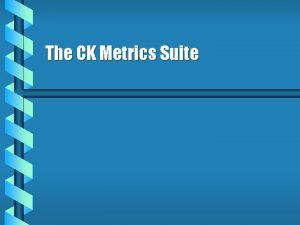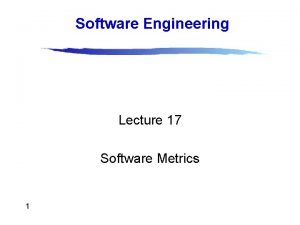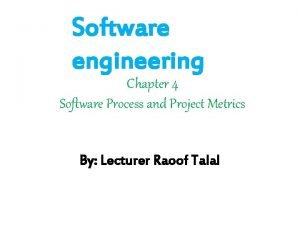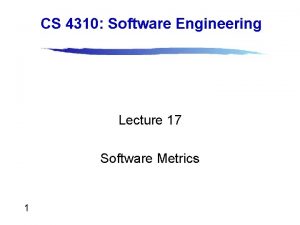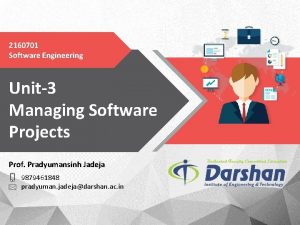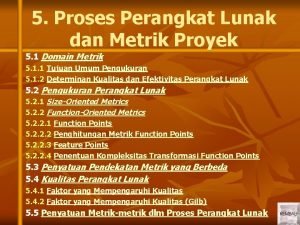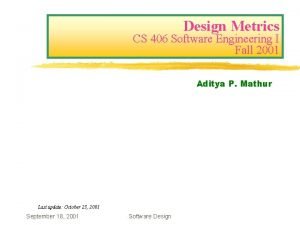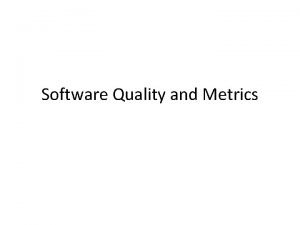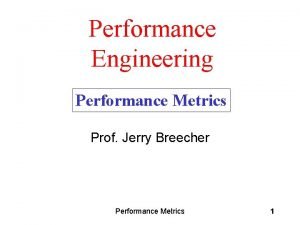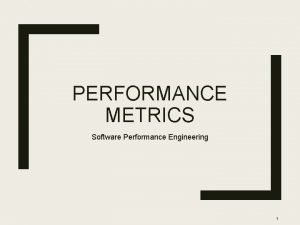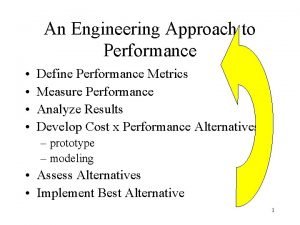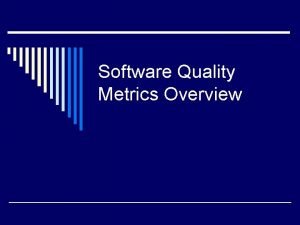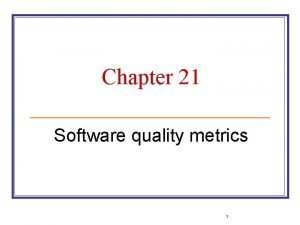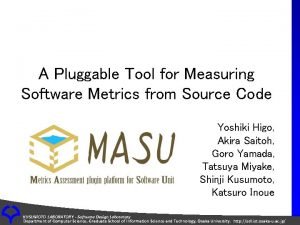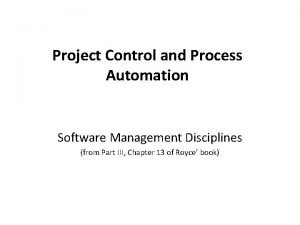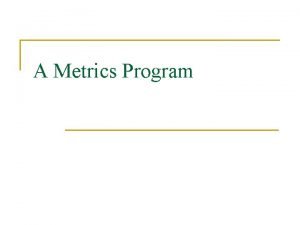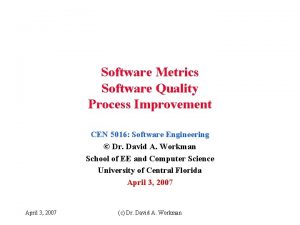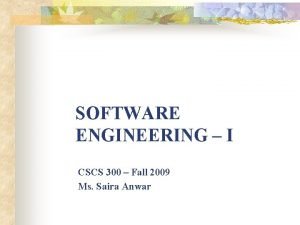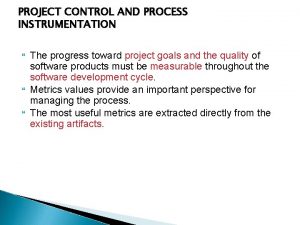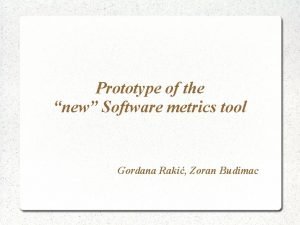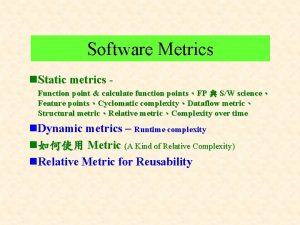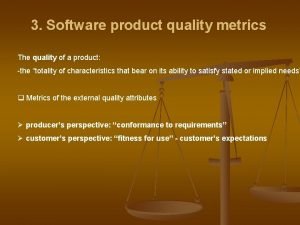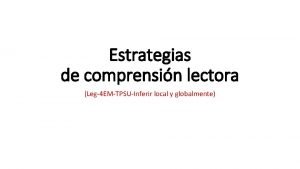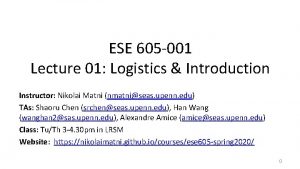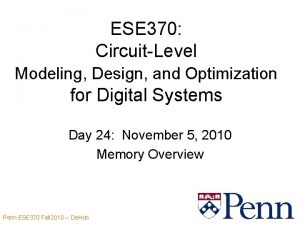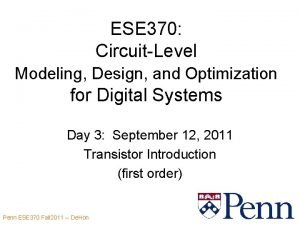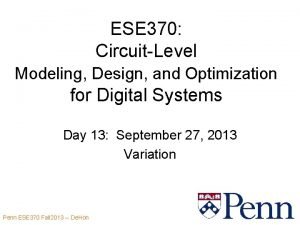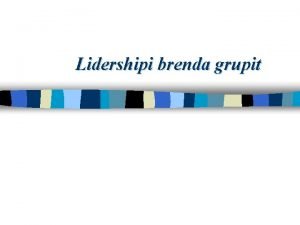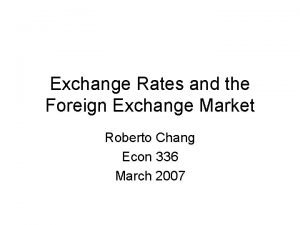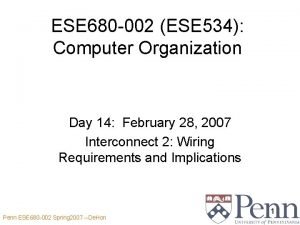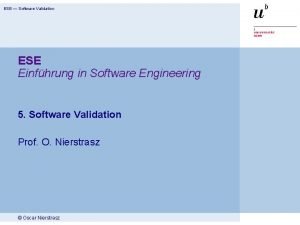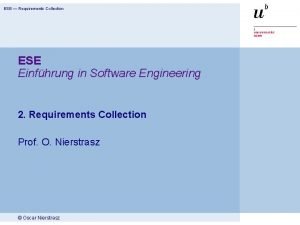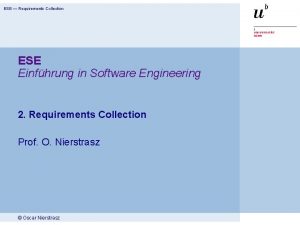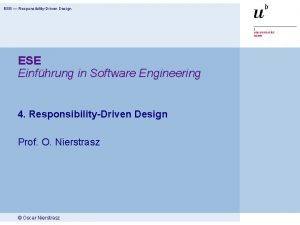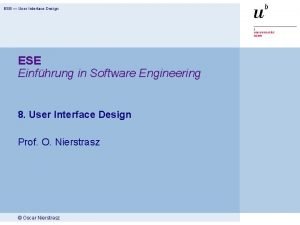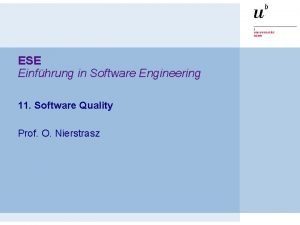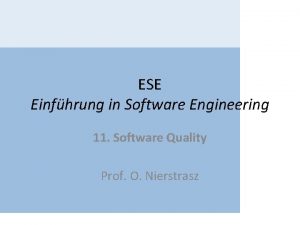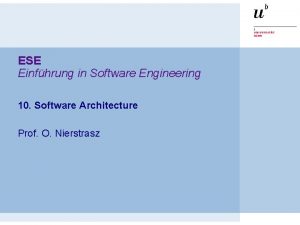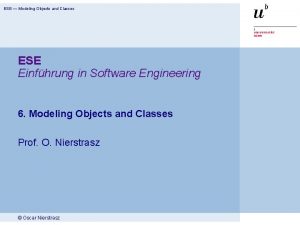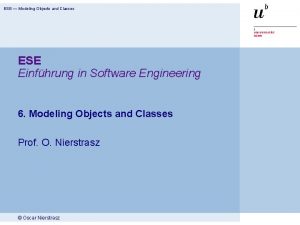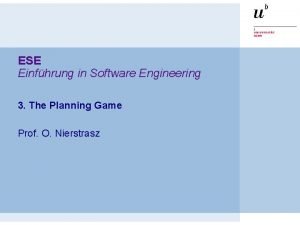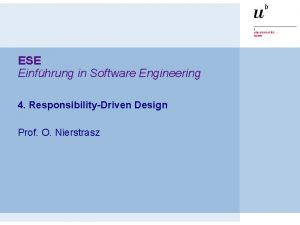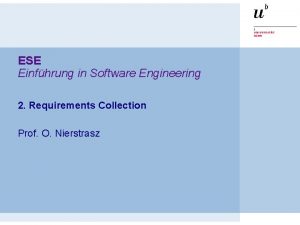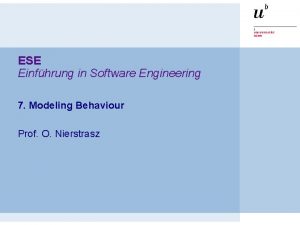ESE Einfhrung in Software Engineering 12 Software Metrics

























































- Slides: 57

ESE Einführung in Software Engineering 12. Software Metrics Prof. O. Nierstrasz

ESE — Software Metrics Roadmap > What are metrics? Why do we need them? > Metrics for cost estimation > Metrics for software quality evaluation > Object-Oriented metrics in practice © Oscar Nierstrasz ESE 12. 2

ESE — Software Metrics Sources > Software Engineering, I. Sommerville, Addison-Wesley, Fifth Edn. , 1996. > Software Metrics: A Rigorous & Practical Approach, Norman E. Fenton, Shari l. Pfleeger, Thompson Computer Press, 1996. © Oscar Nierstrasz ESE 12. 3

ESE — Software Metrics Roadmap > What are metrics? Why do we need them? > Metrics for cost estimation > Metrics for software quality evaluation > Object-Oriented metrics in practice © Oscar Nierstrasz ESE 12. 4

ESE — Software Metrics Why Metrics? When you can measure what you are speaking about and express it in numbers, you know something about it; but when you cannot measure, when you cannot express it in numbers, your knowledge is of a meagre and unsatisfactory kind: it may be the beginning of knowledge, but you have scarcely, in your thoughts, advanced to the stage of science. — Lord Kelvin © Oscar Nierstrasz ESE 12. 5

ESE — Software Metrics Why Measure Software? Estimate cost and effort Improve productivity Improve software quality Improve reliability Evaluate methods and tools measure correlation between specifications and final product measure value and cost of software measure usability, efficiency, maintainability. . . measure mean time to failure, etc. measure productivity, quality, reliability. . . “You cannot control what you cannot measure” — De Marco, 1982 “What is not measurable, make measurable” — Galileo © Oscar Nierstrasz ESE 12. 6

ESE — Software Metrics What are Software Metrics? Software metrics > Any type of measurement which relates to a software system, process or related documentation — Lines of code in a program — the Fog index (calculates readability of a piece of documentation) 0. 4 (# words / # sentences) + (% words ≥ 3 syllables) — number of person-days required to implement a use-case © Oscar Nierstrasz ESE 12. 7

ESE — Software Metrics (Measures vs Metrics) Mathematically, a metric is a function m measuring the distance between two objects such that: 1. 2. 3. x, m(x, x) = 0 x, y, m(x, y) = m(y, x) x, y, z, m(x, z) ≤ m(x, y) + m(y, z) So, technically “software metrics” is an abuse of terminology, and we should instead talk about “software measures”. © Oscar Nierstrasz ESE 12. 8

ESE — Software Metrics Direct and Indirect Measures Direct Measures > Measured directly in terms of the observed attribute (usually by counting) — Length of source-code, Duration of process, Number of defects discovered Indirect Measures > Calculated from other direct and indirect measures — Module Defect Density = Number of defects discovered / Length of source — Temperature (usually derived from the length of a liquid column) © Oscar Nierstrasz ESE 12. 9

ESE — Software Metrics Measurement Mapping Measure & Measurement A measure is a function mapping an attribute of a real world entity (= the domain) onto a symbol in a set with known mathematical relations (= the range). A measurement is the symbol assigned to the real world attribute by the measure. Frank Laura Joe 1. 80 1. 65 1. 73 Example: measure mapping height attribute of person on a number representing height in meters. Purpose: Manipulate symbol(s) in the range to draw conclusions about attribute(s) in the domain © Oscar Nierstrasz ESE 12. 10

ESE — Software Metrics Preciseness To be precise, the definition of the measure must specify: > domain: do we measure people’s height or width? > range: do we measure height in centimetres or inches? > mapping rules: do we allow shoes to be worn? © Oscar Nierstrasz ESE 12. 11

ESE — Software Metrics Possible Problems Example: Compare productivity in lines of code per time unit. Do we use the same units What is a “line of code”? to compare? What is the “time unit”? Is the context the same? Were programmers familiar with the language? Is “code size” really what we want to produce? What about code quality? How do we want to interpret results? Average productivity of a programmer? Programmer X is twice as productive as Y? What do we want to do with the results? Do you reward “productive” programmers? Do you compare productivity of software processes? © Oscar Nierstrasz ESE 12. 12

ESE — Software Metrics GQM Goal — Question — Metrics approach [Basili et al. 1984] > Define Goal — e. g. , “How effective is the coding standard XYZ? ” > Break down into Questions — “Who is using XYZ? ” — “What is productivity/quality with/without XYZ? ” > Pick suitable Metrics — Proportion of developers using XYZ — Their experience with XYZ. . . — Resulting code size, complexity, robustness. . . © Oscar Nierstrasz ESE 12. 13

ESE — Software Metrics Validity and reliability > A good metric is both valid (measures what it is intended to measure) and reliable (yields consistent results) Reliable but not valid Valid but not reliable Valid and reliable See: Stephen H. Kan, Metrics and Models in Software Quality Engineering, Addison Wesley, 2002. Ch. 3. 4 © Oscar Nierstrasz ESE 12. 14

ESE — Software Metrics Some Desirable Properties of Metrics > Valid and reliable (consistent) > Objective, precise > Intuitive Caveat: Attempts to define formally desirable properties have been heavily disputed … > Robust (failure-tolerant) > Automatable and economical (practical) > … See: 2. Brian Henderson-Sellers, Object-Oriented Metrics: Measures of Complexity, Prentice-Hall, 1996, Ch. 2. 6 © Oscar Nierstrasz ESE 12. 15

ESE — Software Metrics Roadmap > What are metrics? Why do we need them? > Metrics for cost estimation > Metrics for software quality evaluation > Object-Oriented metrics in practice © Oscar Nierstrasz ESE 12. 16

ESE — Software Metrics Cost estimation objectives Cost estimation and planning/scheduling are closely related activities Goals > To establish a budget for a software project > To provide a means of controlling project costs > To monitor progress against the budget — comparing planned with estimated costs > To establish a cost database for future estimation © Oscar Nierstrasz ESE 12. 17

ESE — Software Metrics Estimation techniques Expert judgement cheap, but risky! Estimation by analogy limited applicability Parkinson's Law unlimited risk! Pricing to win i. e. , you do what you can with the money Top-down estimation may miss low-level problems Bottom-up estimation may underestimate integration costs Algorithmic cost modelling requires correlation data Each method has strengths and weaknesses! Estimation should be based on several methods © Oscar Nierstrasz ESE 12. 18

ESE — Software Metrics Algorithmic cost modelling > Cost is estimated as a mathematical function of product, project and process attributes whose values are estimated by project managers > The function is derived from a study of historical costing data > Most commonly used product attribute for cost estimation is LOC (code size) > Most models are basically similar but with different attribute values © Oscar Nierstrasz ESE 12. 19

ESE — Software Metrics Measurement-based estimation A. Measure Develop a system model and measure its size C. Interpret Adapt the effort with respect to a specific Development Project Plan B. Estimate Determine the effort with respect to an empirical database of measurements from similar projects © Oscar Nierstrasz ESE 12. 20

ESE — Software Metrics Lines of code Lines of Code as a measure of system size? > Easy to measure; but not well-defined for modern languages — What's a line of code? > A poor indicator of productivity — Ignores software reuse, code duplication, benefits of redesign — The lower level the language, the more productive the programmer! — The more verbose the programmer, the higher the productivity! © Oscar Nierstrasz ESE 12. 21

ESE — Software Metrics Function points Function Points (Albrecht, 1979) > Based on a combination of program characteristics: — — external inputs and outputs user interactions external interfaces files used by the system A weight is associated with each of these > The function point count is computed by multiplying each raw count by the weight and summing all values > Function point count modified by complexity of the project > © Oscar Nierstrasz ESE 12. 22

ESE — Software Metrics Function points Good points, bad points > Can be measured already after design > FPs can be used to estimate LOC depending on the average number of LOC per FP for a given language > LOC can vary wildly in relation to FP > FPs are very subjective — depend on the estimator. They cannot be counted automatically © Oscar Nierstrasz ESE 12. 23

ESE — Software Metrics Programmer productivity A measure of the rate at which individual engineers involved in software development produce software and associated documentation Productivity metrics > Size-related measures based on some output from the software process. This may be lines of delivered source code, object code instructions, etc. > Function-related measures based on an estimate of the functionality of the delivered software. Function-points are the best known of this type of measure … © Oscar Nierstrasz ESE 12. 24

ESE — Software Metrics Programmer productivity … Productivity estimates > Real-time embedded systems, 40 -160 LOC/P-month > Systems programs , 150 -400 LOC/P-month > Commercial applications, 200 -800 LOC/P-month Quality and productivity > All metrics based on volume/unit time are flawed because they do not take quality into account — Productivity may generally be increased at the cost of quality — It is not clear how productivity/quality metrics are related © Oscar Nierstrasz ESE 12. 25

ESE — Software Metrics The COCOMO model > Developed at TRW, a US defence contractor > Based on a cost database of more than 60 different projects > Exists in three stages 1. 2. 3. Basic — Gives a “ball-park” estimate based on product attributes Intermediate — Modifies basic estimate using project and process attributes Advanced — Estimates project phases and parts separately © Oscar Nierstrasz ESE 12. 26

ESE — Software Metrics Basic COCOMO Formula > Effort = C PMS M — Effort is measured in person-months — C is a complexity factor — PM is a product metric (size or functionality, usually KLOC) — exponent S is close to 1, but increasing for large projects — M is a multiplier based on process, product and development attributes (~ 1) © Oscar Nierstrasz ESE 12. 27

ESE — Software Metrics COCOMO Project classes Organic mode: small teams, familiar environment, well-understood applications, no difficult non-functional requirements (EASY) Effort = 2. 4 (KDSI) 1. 05 M Semi-detached mode: Project team may have experience mixture, system may have more significant non-functional constraints, organization may have less familiarity with application (HARDER) Effort = 3 (KDSI) 1. 12 M Embedded: Hardware/software systems, tight constraints, unusual for team to have deep application experience (HARD) Effort = 3. 6 (KDSI) 1. 2 M KDSI = Kilo Delivered Source Instructions © Oscar Nierstrasz ESE 12. 28

ESE — Software Metrics COCOMO assumptions and problems > Implicit productivity estimate — Organic mode = 16 LOC/day — Embedded mode = 4 LOC/day > Time required is a function of total effort not team size > Not clear how to adapt model to personnel availability © Oscar Nierstrasz http: //en. wikipedia. org/wiki/Fair_use ESE 12. 29

ESE — Software Metrics COCOMO assumptions and problems. . . > Staff required can’t be computed by dividing the development time by the required schedule > The number of people working on a project varies depending on the phase of the project > The more people who work on the project, the more total effort is usually required (!) > Very rapid build-up of people often correlates with schedule slippage © Oscar Nierstrasz ESE 12. 30

ESE — Software Metrics Roadmap > What are metrics? Why do we need them? > Metrics for cost estimation > Metrics for software quality evaluation > Object-Oriented metrics in practice © Oscar Nierstrasz ESE 12. 31

ESE — Software Metrics Quantitative Quality Model Quality according to ISO 9126 standard > Divide-and conquer approach via “hierarchical quality model” > Leaves are simple metrics, measuring basic attributes Functionality Reliability Software Quality Efficiency Usability © Oscar Nierstrasz Accuracy Consistency defect density = #defects / size Simplicity correction time Portability Modularity correction impact = #components changed Factor Characteristic Metric Maintainability ISO 9126 Error tolerance ESE 12. 32

ESE — Software Metrics “Define your own” Quality Model Define the quality model with the development team > Team chooses the characteristics, design principles, metrics. . . and the thresholds Maintainability Factor © Oscar Nierstrasz Modularity Characteristic design class as an abstract data-type number of private attributes ]2, 10[ encapsulate all attributes number of public attributes ]0, 0[ avoid complex interfaces number of public methods ]5, 30[ average number of arguments [0, 4[ Design Principle Metric ESE 12. 33

ESE — Software Metrics Sample Size (and Inheritance) Metrics Class Size Metrics - # methods (NOM) - # attributes, instance/class (NIA, NCA) - # S of method size (WMC) Inheritance Metrics - hierarchy nesting level (HNL) - # immediate children (NOC) - # inherited methods, unmodified (NMI) - #overridden methods (NMO) Class inherits Method invokes © Oscar Nierstrasz belongs. To access Method Size Metrics - # invocations (NOI) - # statements (NOS) - # lines of code (LOC) - # arguments (NOA) Attribute ESE 12. 34

ESE — Software Metrics Sample Coupling & Cohesion Metrics The following definitions stem from [Chid 91 a], later republished as [Chid 94 a] Coupling Between Objects (CBO) CBO = number of other classes to which given class is coupled Interpret as “number of other classes a class requires to compile” Lack of Cohesion in Methods (LCOM) LCOM = number of disjoint sets (= not accessing same attribute) of local methods © Oscar Nierstrasz ESE 12. 35

ESE — Software Metrics Coupling & Cohesion Metrics Beware! Researchers disagree whether coupling/cohesion methods are valid > Classes that are observed to be cohesive may have a high LCOM value — due to accessor methods > Classes that are not much coupled may have high CBO value — no distinction between data, method or inheritance coupling © Oscar Nierstrasz ESE 12. 36

ESE — Software Metrics Sample Quality Metrics (I) Productivity (Process Metric) > functionality / time > functionality in LOC or FP; time in hours, weeks, months — be careful to compare: the same unit does not always represent the same > Does not take into account the quality of the functionality! © Oscar Nierstrasz ESE 12. 37

ESE — Software Metrics Sample Quality Metrics (II) Reliability (Product Metric) > mean time to failure = mean of probability density function PDF — for software one must take into account the fact that repairs will influence the rest of the function quite complicated formulas > average time between failures = # failures / time — time in execution time or calendar time — necessary to calibrate the probability density function > mean time between failure = MTTF + mean time to repair — to know when your system will be available, take into account repair © Oscar Nierstrasz ESE 12. 38

ESE — Software Metrics Sample Quality Metrics (III) Correctness (Product Metric) > “a system is correct or not, so one cannot measure correctness” > defect density = # known defects / product size — product size in LOC or FP — # known defects is a time based count! > do not compare across projects unless your data collection is sound! © Oscar Nierstrasz ESE 12. 39

ESE — Software Metrics Sample Quality Metrics (IV) Maintainability (Product Metric) > #time to repair certain categories of changes > “mean time to repair” vs. “average time to repair” — similar to “mean time to failure” and “average time between failures” > beware of the units — “categories of changes” is subjective — time =? problem recognition time + administrative delay time + problem analysis time + change time + testing & reviewing time © Oscar Nierstrasz ESE 12. 40

ESE — Software Metrics Roadmap > What are metrics? Why do we need them? > Metrics for cost estimation > Metrics for software quality evaluation > Object-Oriented metrics in practice Michele Lanza and Radu Marinescu, Object-Oriented Metrics in Practice, Springer-Verlag, 2006 © Oscar Nierstrasz ESE 12. 41

ESE — Software Metrics Pattern: Study the Exceptional Entities Problem — How can you quickly gain insight into complex software? Solution — Measure software entities and study the anomalous ones Steps — Use simple metrics — Visualize metrics to get an overview — Browse the code to get insight into the anomalies © Oscar Nierstrasz ESE 12. 42

ESE — Software Metrics System Complexity View Nodes = Classes Edges = Inheritance Relationships Width = Number of Attributes Height = Number of Methods Color = Number of Lines of © Oscar Nierstrasz Width Metric Height Metric Position Metrics Color Metric ESE 12. 43

ESE — Software Metrics Detection strategy > A detection strategy is a metrics-based predicate to identify candidate software artifacts that conform to (or violate) a particular design rule © Oscar Nierstrasz ESE 12. 44

ESE — Software Metrics Filters and composition > A data filter is a predicate used to focus attention on a subset of interest of a larger data set — Statistical filters – I. e. , top and bottom 25% are considered outliers — Other relative thresholds – I. e. , other percentages to identify outliers (e. g. , top 10%) — Absolute thresholds – I. e. , fixed criteria, independent of the data set > A useful detection strategy can often be expressed as a composition of data filters © Oscar Nierstrasz ESE 12. 45

ESE — Software Metrics God Class > A God Class centralizes intelligence in the system — Impacts understandibility — Increases system fragility © Oscar Nierstrasz ESE 12. 46

ESE — Software Metrics Model. Facade (Argo. UML) > 453 methods > 114 attributes > over 3500 LOC > all methods and all attributes are static © Oscar Nierstrasz ESE 12. 47

ESE — Software Metrics Feature Envy > Methods that are more interested in data of other classes than their own [Fowler et al. 99] © Oscar Nierstrasz ESE 12. 48

ESE — Software Metrics Class. Diagram. Layouter © Oscar Nierstrasz ESE 12. 49

ESE — Software Metrics Data Class > A Data Class provides data to other classes but little or no functionality of its own © Oscar Nierstrasz ESE 12. 50

ESE — Software Metrics Data Class (2) © Oscar Nierstrasz ESE 12. 51

ESE — Software Metrics Property © Oscar Nierstrasz ESE 12. 52

ESE — Software Metrics Shotgun Surgery > A change in an operation implies many (small) changes to a lot of different operations and classes © Oscar Nierstrasz ESE 12. 53

ESE — Software Metrics Project © Oscar Nierstrasz ESE 12. 54

ESE — Software Metrics What you should know! > What is a measure? What is a metric? > What is GQM? > What are three phases of algorithmic cost modelling? > What problems arise when using LOC as a software metric? > What are the key ideas behind COCOMO? > What’s the difference between “Mean time to failure” and “Average time between failures”? Why is the difference important? © Oscar Nierstrasz ESE 12. 55

ESE — Software Metrics Can you answer the following questions? > During which phases in a software project would you use metrics? > Is the Fog index a “good” metric? > How would you measure your own software productivity? > Why are coupling/cohesion metrics important? Why then are they so rarely used? © Oscar Nierstrasz ESE 12. 56

ESE — Software Metrics License > http: //creativecommons. org/licenses/by-sa/3. 0/ Attribution-Share. Alike 3. 0 Unported You are free: to Share — to copy, distribute and transmit the work to Remix — to adapt the work Under the following conditions: Attribution. You must attribute the work in the manner specified by the author or licensor (but not in any way that suggests that they endorse you or your use of the work). Share Alike. If you alter, transform, or build upon this work, you may distribute the resulting work only under the same, similar or a compatible license. For any reuse or distribution, you must make clear to others the license terms of this work. The best way to do this is with a link to this web page. Any of the above conditions can be waived if you get permission from the copyright holder. Nothing in this license impairs or restricts the author's moral rights. © Oscar Nierstrasz ESE 12. 57
 What is software metrics in software engineering
What is software metrics in software engineering Software measurement and metrics
Software measurement and metrics Ck metrics in software engineering
Ck metrics in software engineering Data structure metrics in software engineering
Data structure metrics in software engineering Process and project metrics in software engineering
Process and project metrics in software engineering Function point metrics in software engineering
Function point metrics in software engineering Function point metrics in software engineering
Function point metrics in software engineering Project metrics in software engineering
Project metrics in software engineering Project metrics example
Project metrics example Design metrics in software engineering
Design metrics in software engineering Quality metrics in software engineering
Quality metrics in software engineering Engineering performance metrics
Engineering performance metrics Software performance metrics
Software performance metrics Engineering performance metrics
Engineering performance metrics Computer based system engineering in software engineering
Computer based system engineering in software engineering Forward engineering in software engineering
Forward engineering in software engineering Quality metrics examples
Quality metrics examples Software productivity metrics formula
Software productivity metrics formula Software metrics tool
Software metrics tool Scdgs
Scdgs Seven core metrics in software project management
Seven core metrics in software project management The intent of project metrics is:
The intent of project metrics is: Limitations of software metrics
Limitations of software metrics Software metrics validation
Software metrics validation Industrial software metrics top 10 list
Industrial software metrics top 10 list Seven core metrics of software project
Seven core metrics of software project Software quality metrics
Software quality metrics Software metrics tool
Software metrics tool Function point analysis example
Function point analysis example Software security metrics
Software security metrics Product quality metrics
Product quality metrics Software maintenance in software engineering ppt
Software maintenance in software engineering ppt Who invented software engineering
Who invented software engineering Types of software crisis
Types of software crisis Real time software design in software engineering
Real time software design in software engineering Design principles in software engineering
Design principles in software engineering Shoqeria ese argumentuese
Shoqeria ese argumentuese Sjellja konsumatore
Sjellja konsumatore E drejta per respektimin e jetes private
E drejta per respektimin e jetes private Jeta e shekspirit
Jeta e shekspirit Lufta e pare boterore projekt
Lufta e pare boterore projekt Ferri jane te tjeret ese
Ferri jane te tjeret ese Korn ese viejo nuevo metal
Korn ese viejo nuevo metal Ese605
Ese605 Ese 532
Ese 532 Ese 532
Ese 532 Ese 532
Ese 532 Ese 532
Ese 532 Ese 370
Ese 370 Ese 370
Ese 370 Ese 370
Ese 370 Ese 370
Ese 370 Exemplos de frases conotativas
Exemplos de frases conotativas Lidershipi ese
Lidershipi ese Exchange rate definition
Exchange rate definition Ese
Ese How to make a project
How to make a project Ese
Ese


